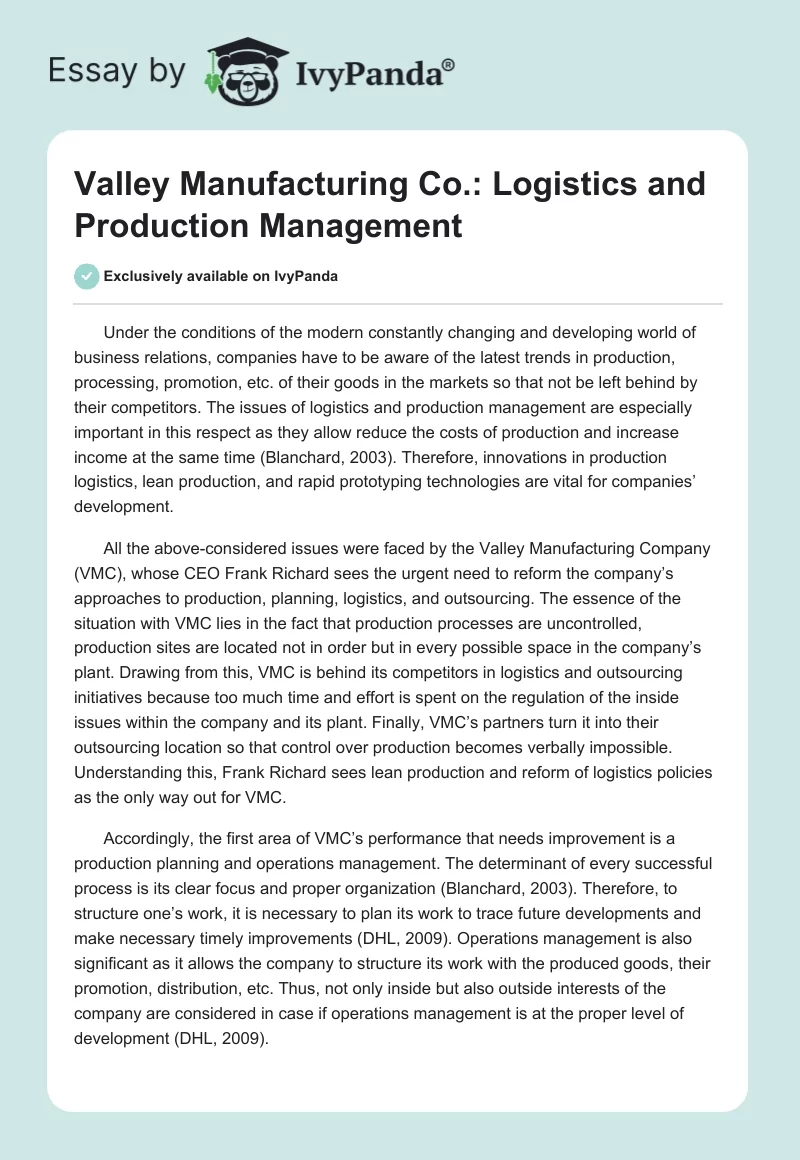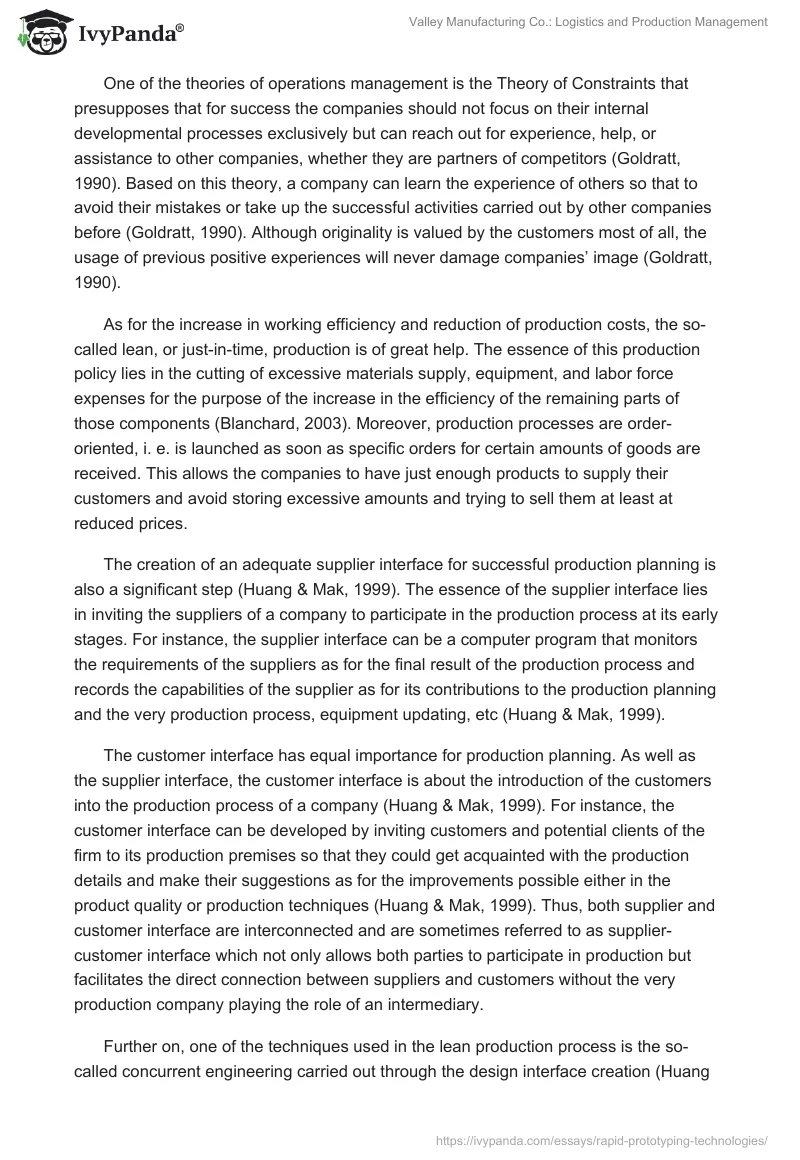Under the conditions of the modern constantly changing and developing world of business relations, companies have to be aware of the latest trends in production, processing, promotion, etc. of their goods in the markets so that not be left behind by their competitors. The issues of logistics and production management are especially important in this respect as they allow reduce the costs of production and increase income at the same time (Blanchard, 2003). Therefore, innovations in production logistics, lean production, and rapid prototyping technologies are vital for companies’ development.
All the above-considered issues were faced by the Valley Manufacturing Company (VMC), whose CEO Frank Richard sees the urgent need to reform the company’s approaches to production, planning, logistics, and outsourcing. The essence of the situation with VMC lies in the fact that production processes are uncontrolled, production sites are located not in order but in every possible space in the company’s plant. Drawing from this, VMC is behind its competitors in logistics and outsourcing initiatives because too much time and effort is spent on the regulation of the inside issues within the company and its plant. Finally, VMC’s partners turn it into their outsourcing location so that control over production becomes verbally impossible. Understanding this, Frank Richard sees lean production and reform of logistics policies as the only way out for VMC.
Accordingly, the first area of VMC’s performance that needs improvement is a production planning and operations management. The determinant of every successful process is its clear focus and proper organization (Blanchard, 2003). Therefore, to structure one’s work, it is necessary to plan its work to trace future developments and make necessary timely improvements (DHL, 2009). Operations management is also significant as it allows the company to structure its work with the produced goods, their promotion, distribution, etc. Thus, not only inside but also outside interests of the company are considered in case if operations management is at the proper level of development (DHL, 2009).
One of the theories of operations management is the Theory of Constraints that presupposes that for success the companies should not focus on their internal developmental processes exclusively but can reach out for experience, help, or assistance to other companies, whether they are partners of competitors (Goldratt, 1990). Based on this theory, a company can learn the experience of others so that to avoid their mistakes or take up the successful activities carried out by other companies before (Goldratt, 1990). Although originality is valued by the customers most of all, the usage of previous positive experiences will never damage companies’ image (Goldratt, 1990).
As for the increase in working efficiency and reduction of production costs, the so-called lean, or just-in-time, production is of great help. The essence of this production policy lies in the cutting of excessive materials supply, equipment, and labor force expenses for the purpose of the increase in the efficiency of the remaining parts of those components (Blanchard, 2003). Moreover, production processes are order-oriented, i. e. is launched as soon as specific orders for certain amounts of goods are received. This allows the companies to have just enough products to supply their customers and avoid storing excessive amounts and trying to sell them at least at reduced prices.
The creation of an adequate supplier interface for successful production planning is also a significant step (Huang & Mak, 1999). The essence of the supplier interface lies in inviting the suppliers of a company to participate in the production process at its early stages. For instance, the supplier interface can be a computer program that monitors the requirements of the suppliers as for the final result of the production process and records the capabilities of the supplier as for its contributions to the production planning and the very production process, equipment updating, etc (Huang & Mak, 1999).
The customer interface has equal importance for production planning. As well as the supplier interface, the customer interface is about the introduction of the customers into the production process of a company (Huang & Mak, 1999). For instance, the customer interface can be developed by inviting customers and potential clients of the firm to its production premises so that they could get acquainted with the production details and make their suggestions as for the improvements possible either in the product quality or production techniques (Huang & Mak, 1999). Thus, both supplier and customer interface are interconnected and are sometimes referred to as supplier-customer interface which not only allows both parties to participate in production but facilitates the direct connection between suppliers and customers without the very production company playing the role of an intermediary.
Further on, one of the techniques used in the lean production process is the so-called concurrent engineering carried out through the design interface creation (Huang & Mak, 1999). Concurrent engineering presupposes the use of a multi-skilled labor force to enable the company to deal with design engineering, manufacturing engineering, etc. all at the same period of time. Thus, the production process becomes more time-saving and less costly as there is no need to employ for example 10 people with different skills when there are 5 people who have skills in two or more areas of engineering. Therefore, the design interface is the introduction of design engineering to the production process carried out by the lean method.
The rapid prototyping technique is also a valuable mass production tool as it allows the company to produce large amounts of similar goods at small periods of time and at little cost (Blanchard, 2003). Mass production, and rapid prototyping, involve little manual work of employees while the production process is computerized, which allows reducing costs of goods produced by the rapid prototyping techniques. Rapid prototyping suggested first by Henry Ford in the form of mass production can actually reduce production expenses and goods prices by the little costs it demands from the producing company (Blanchard, 2003).
Finally, the resource allocation procedure is another important tool of production efficiency increase and costs cutting. The essence of resource allocation lies in distributing the resources observed among the parts of the company in accordance with their needs. In other words, the department of the company that brings the bulk of income will be provided with more resources, while the departments proving to be inefficient is either provided with fewer resources or restructured to work effectively at the lowest costs possible (Blanchard, 2003). Thus, resources allocation allows saving funds and resources and using them with the highest degree of efficiency.
To conclude, innovations in production logistics, lean production, and rapid prototyping technologies are vital for companies’ development. The major phenomena that might assist in increasing the company’s efficiency and cutting its expenses are production planning and operations management, supplier, customer, and design interfaces, rapid prototyping techniques, and the proper resource allocation practices. If implemented properly, these policies allow the company to reduce its expenses and increase the efficiency of its production process.
References
- Blanchard, B. (2003). Logistics Engineering and Management. Prentice Hall; 6 edition.
- DHL. (2009). The Important Form Question for Production. Retrieved July 17, 2009, from Discover Logistics.
- Goldratt, Eliyahu M. (1990). What is this thing called Theory of Constraints and how should it be implemented? North River Press.
- Huang, G. Q., Mak, K. L. (1999). “Modelling the Customer-Supplier Interface over the World Wide Web to Facilitate Early Supplier Involvement in New Product Development”, Institution of Mechanical Engineers Proceedings, Part B Journal of Engineering Manufacture, 2000, B214(9): 759-769.


